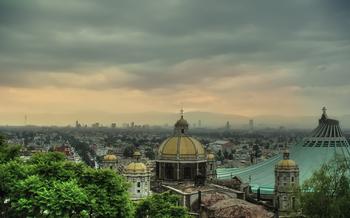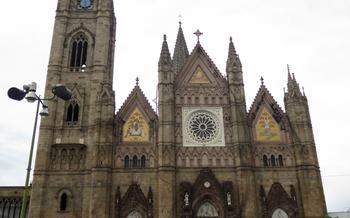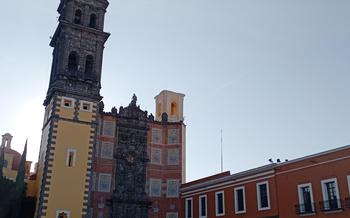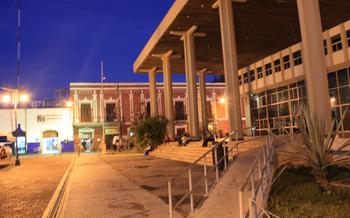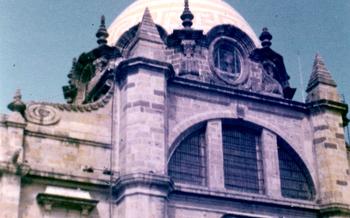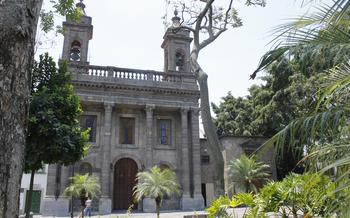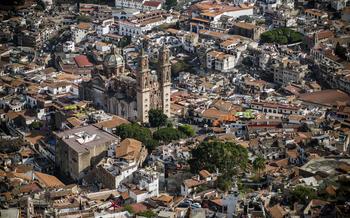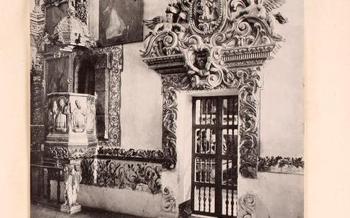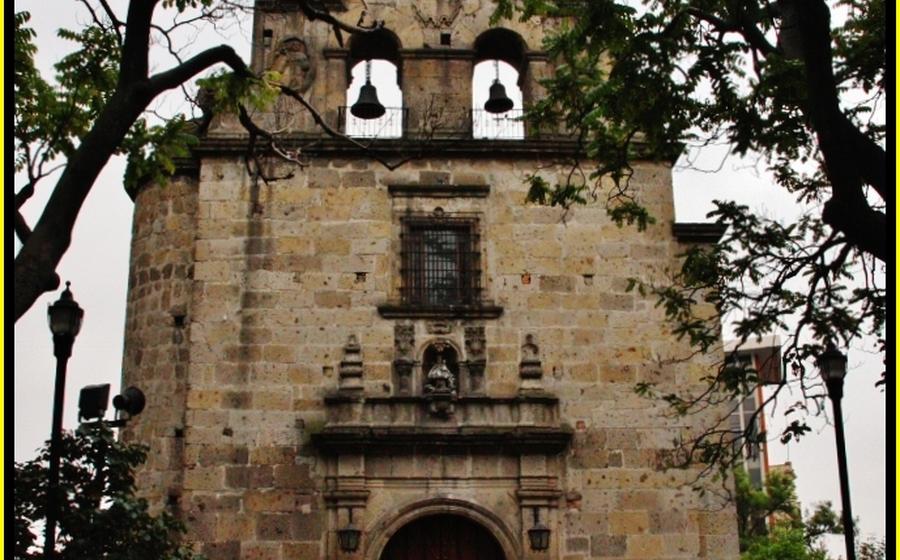
Templo de Aranzazú
- Templo de Aranzazú: An Architectural Masterpiece
- Intricate Façade and Sculptures
- The Majestic Altars
- A Haven for Art and Culture
- A Place of Worship and Community
- Stunning Stained Glass Windows
- Explore the Templo's Museum
- Attend a Religious Service
- Capture the Essence through Photography
Templo de Aranzazú: An Architectural Masterpiece
The Templo de Aranzazú, a prominent landmark in Guadalajara, Mexico, stands as a testament to the city's rich architectural heritage. Its construction, initiated in 1689, showcases a blend of architectural styles that have shaped its unique identity over the centuries. The temple's façade, a masterpiece of Baroque architecture, features intricate carvings and sculptures that depict biblical scenes and religious figures. The interior, adorned with opulent decorations, displays a fusion of Gothic and Neoclassical elements, creating a harmonious and awe-inspiring space.
The design of the temple is deeply rooted in symbolism and religious significance. The octagonal dome, a defining feature of the building, represents the eight beatitudes mentioned in the Sermon on the Mount. The intricate carvings on the façade narrate biblical stories and serve as a visual representation of the teachings of the Catholic faith. The temple's grandeur and attention to detail reflect the devotion and artistry of the builders who sought to create a sacred space that would inspire and uplift the spirits of worshippers.
Intricate Façade and Sculptures
The façade of the Templo de Aranzazú is a masterpiece of Baroque architecture, characterized by its intricate carvings, sculptures, and reliefs. The main portal is flanked by two bell towers, each topped by a dome, creating a harmonious and symmetrical composition. The façade is adorned with sculptures of saints, angels, and biblical scenes, which narrate the life of the Virgin Mary and the history of the Catholic Church. The sculptures are made of cantera stone, a local volcanic rock, and showcase the skill and artistry of the indigenous craftsmen who created them.
The most notable sculpture is the image of the Virgin of Aranzazú, which occupies the central niche of the façade. The Virgin is depicted standing on a crescent moon, surrounded by clouds and angels. Her face exudes a serene and compassionate expression, reflecting the devotion and love that the people of Guadalajara have for her. The attention to detail in the carving of the Virgin's garments, her delicate features, and the intricate folds of her cloak is truly remarkable.
Other notable sculptures on the façade include depictions of the Four Evangelists, Saint Peter, Saint Paul, and the Archangel Michael. Each sculpture is unique in its design and symbolism, adding to the overall richness and complexity of the façade. The combination of these sculptures with the intricate carvings and reliefs creates a visually stunning and awe-inspiring spectacle that leaves visitors in awe.
The Majestic Altars
The Templo de Aranzazú boasts a series of majestic altars that captivate the eyes and inspire awe. The main altar, a masterpiece of Baroque architecture, stands as the centerpiece of the temple, adorned with intricate carvings and gilded embellishments. Its grandeur is further enhanced by the use of marble, creating a harmonious blend of elegance and spirituality.
Smaller altars, each dedicated to a different saint, are scattered throughout the temple, adding to its rich tapestry of religious devotion. These altars serve as focal points for prayer and contemplation, inviting visitors to seek solace and guidance from the saints. The artistry and craftsmanship exhibited in these altars reflect the deep devotion and reverence held by the community.
A Haven for Art and Culture
The Templo de Aranzazú is not just a religious site but also a haven for art and culture. Its interior is adorned with a remarkable collection of religious art and paintings that reflect the influence of both European and Mexican artistic styles. These artworks are not mere decorations but powerful tools for storytelling and spiritual contemplation.
The most striking paintings depict biblical scenes and the lives of saints, inviting visitors to engage with the stories that have shaped Christianity. Each artwork is a testament to the skill and devotion of the artists who created them, using vibrant colors, intricate details, and symbolic imagery to convey religious messages and inspire awe.
Beyond the paintings, the temple also boasts a collection of sculptures and carvings that showcase the artistry and craftsmanship of the era. From the intricate carvings on the main altar to the delicate statues of saints, each piece contributes to the overall grandeur and spiritual atmosphere of the temple.
The combination of art and architecture in the Templo de Aranzazú creates a unique and immersive experience for visitors. The artworks not only enhance the beauty of the space but also serve as a reminder of the rich history, beliefs, and traditions that have shaped the religious and cultural heritage of Guadalajara.
A Place of Worship and Community
Templo de Aranzazú serves as a vibrant center for religious services and community gatherings. The solemn celebration of the Eucharist, the holiest sacrament in Catholicism, takes place within its sacred walls, fostering a profound connection between the faithful and the divine. Beyond the regular Mass, the temple hosts a variety of sacraments, including baptisms, confirmations, and marriages, marking significant milestones in the lives of its parishioners.
Throughout the year, the temple becomes a hub of activity as it hosts festivals and events that bring together the local community. These celebrations, often centered around religious holidays or the veneration of patron saints, showcase the rich cultural heritage of Guadalajara and provide opportunities for communal bonding and spiritual reflection. The temple's spacious interior and picturesque surroundings create an ideal setting for these joyous gatherings, where locals and visitors alike come together to celebrate their shared faith and traditions.
Stunning Stained Glass Windows
The Templo de Aranzazú is renowned for its breathtaking stained glass windows, which adorn the interior with vibrant colors and intricate designs. These magnificent windows, crafted by skilled artisans, depict scenes from the Bible and stories of saints, bringing to life the narratives of faith and devotion. The stained glass windows serve as a visual testament to the artistry and craftsmanship that went into the creation of this sacred space.
The use of natural light, filtering through the stained glass, creates a magical and ethereal atmosphere within the temple. The interplay of light and color transforms the interior into a kaleidoscope of hues, casting a warm and inviting glow on the surrounding architecture. Each window tells a unique story, inviting visitors to contemplate the mysteries of faith and the lives of those who have dedicated themselves to serving the divine.
The stained glass windows not only enhance the beauty of the temple but also serve as a powerful tool for storytelling and education. They offer a glimpse into the beliefs and values of the Catholic Church, providing a visual representation of the teachings and principles that guide the lives of the faithful. Whether visitors are drawn to the intricate details of the glasswork or the profound symbolism embedded within each scene, the stained glass windows of the Templo de Aranzazú leave a lasting impression on all who behold them.
Explore the Templo's Museum
Step into the Templo de Aranzazú's dedicated museum to delve into the rich history and heritage of this sacred site. Artifacts, ancient documents, and relics, carefully preserved and displayed, narrate the captivating tale of the temple's evolution. Through interactive exhibits and informative panels, visitors gain insights into the daily lives of the monks and the vibrant community that has sustained this remarkable edifice for centuries. The museum serves as a testament to the enduring legacy of the Templo de Aranzazú, offering a profound connection to its spiritual and cultural significance.
Attend a Religious Service
For a truly immersive experience, attend a religious service at the Templo de Aranzazú. Immerse yourself in the beauty of the traditional rituals, the melodic chants, and the palpable devotion of the local community. Witness the profound spiritual connection between the faithful and their beliefs. Attending a religious service here offers a unique opportunity to connect with the local culture and gain a deeper understanding of the significance of this sacred space.
Capture the Essence through Photography
Templo de Aranzazú presents a photographer's paradise, with its intricate details, stunning stained glass windows, and awe-inspiring architecture. To capture the essence of this sacred space, here are some photography tips:
-
Embrace Natural Light: Arrive at sunrise or sunset to harness the warm, golden light that casts a magical glow on the temple's façade.
-
Explore Different Angles: Experiment with various perspectives to showcase the temple's grandeur. Capture wide shots to encompass its scale and intricate details, and don't forget close-ups to highlight specific elements.
-
Pay Attention to Symmetry: The temple's symmetrical design offers a harmonious composition. Position yourself directly in front of the façade to capture its perfect balance.
-
Include People: To convey the temple's significance as a place of worship, include people in your shots. Photograph worshippers praying, families attending mass, or tourists admiring the architecture.
-
Respect the Sacred Space: Remember that the Templo de Aranzazú is an active place of worship. Be respectful of religious ceremonies and avoid using flash photography during services.
